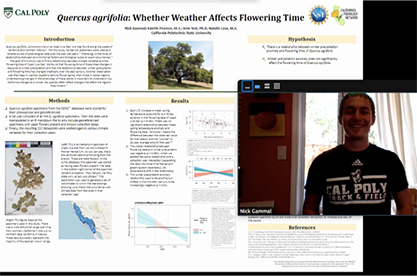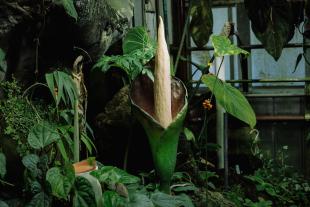Botany Students Study Effects of Climate Change — Using 100-Year-Old Plants

What can 120-year-old flower buds neatly pressed to paper teach you about climate change? As it turns out, a lot.
Nineteen botany students had the chance to dive into more than a century of California’s plant data this spring in an exploration of the nuances plant life using computer programming and statistical analyses.
The class BIO 472 tackled botanical phenology: the study of cyclic and seasonal natural phenomena in plant life. Each student chose a plant species and studied climate's effects on their plant.

Environmental management and protection senior Hannah Romano found inspiration close to home when she chose to look at Salvia mellifera — more commonly known as black sage. The plant is an aromatic native shrub adorned with delicate white and purple flowers, which Romano often sees covering hillsides from San Luis Obispo south to her hometown near San Diego. She assessed how average spring temperatures have affected the plant’s flowering time over the past 100 years.
Connecting the dots on factors like flowering time helps us understand plant behavior as many native species disappear, according to biology Professor Jenn Yost. “This is especially important during our current sixth mass extinction,” she says. “In order to understand change over time, to deal with another crisis — climate change — you have to look at historical records.”
Romano feels these kinds of inquiries can uncover a piece in the larger puzzle of ecosystem health. “Something that’s really important to note is how those plants play a role within their ecosystem and how some species respond to those flowers showing up earlier. Species like insects could have a longer wintering period with less movement and less pollination – they all interact together to affect the larger system as a whole.”
To answer their questions, students had the chance to leverage sizable data sets in the California Phenology Network, including specimens from 48 herbaria throughout the state. Cal Poly’s Hoover Herbarium contributed data from 85,000 samples digitized through a Learn by Doing project funded by the National Science Foundation in 2019. Each student could search the online database to discover hundreds — sometimes thousands — of images of their chosen species and compare them to historical records on temperature, precipitation and more.
The data, including more than 1,000 examples of her plant of choice, helped Romano pinpoint a possible correlation: for every degree Celsius that the average temperature increased, California’s black sage flowered 4.3 days sooner. She says the statistical strength of the data could put this kind of forensic analysis on par with field studies.
Nick Gammal, a first-year marine sciences student, stepped out of his comfort zone to take on this upper division class. He looked at another California native, the Quercus agrifolia, the coast live oak. He investigated how changes in winter precipitation anomalies and spring temperatures altered the tree’s flowering period.

"I have never liked computers. I've always preferred taking notes and solving math by hand," Gammal said. However, "I absolutely loved using R for statistical analysis," he said of the programming language he and his classmates used to find and illustrate trends.
Biology student Leah Makler's study of the bright red wild paintbrush flowers helped her stay connected to Learn by Doing during the virtual spring quarter.
She had plans to travel to the White Mountains to collect research data on paintbrush species with Professor Dena Grossenbacher as part of a Frost Fellowship for undergraduate research, but the trip was cancelled due to the COVID-19 outbreak. Instead, Makler spent her quarter researching specimens from three species at different elevations, discovering how heat and altitude affected flowering trends
“Everybody found a result and found that at least one climate variable was influencing their species,” Makler says. “We know that climate change is having a big impact on living things, but we don’t often recognize that plants are almost impacted more than some animals.
Makler says the quarter’s work may live on: some of the students are choosing to use their findings as the first step toward their senior project with the goal of publishing more conclusive research. But for all, the process of melding climate and plant specimen data gave students a chance to look at California’s landscape a little differently.
“[This class] has given me a taste of what I want to do with my life," says Gammal, "And I feel more enthusiastic than ever about my future.”




